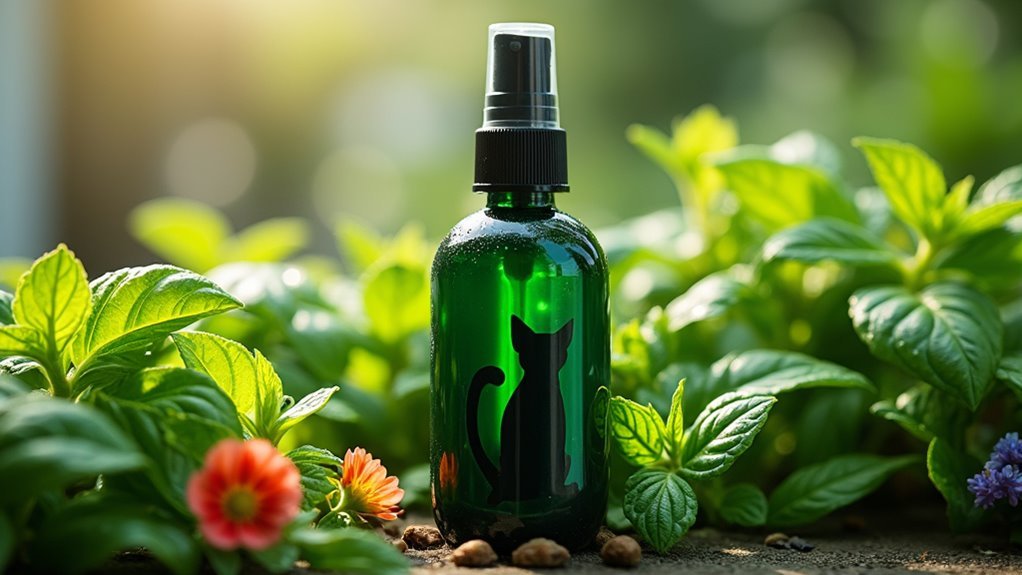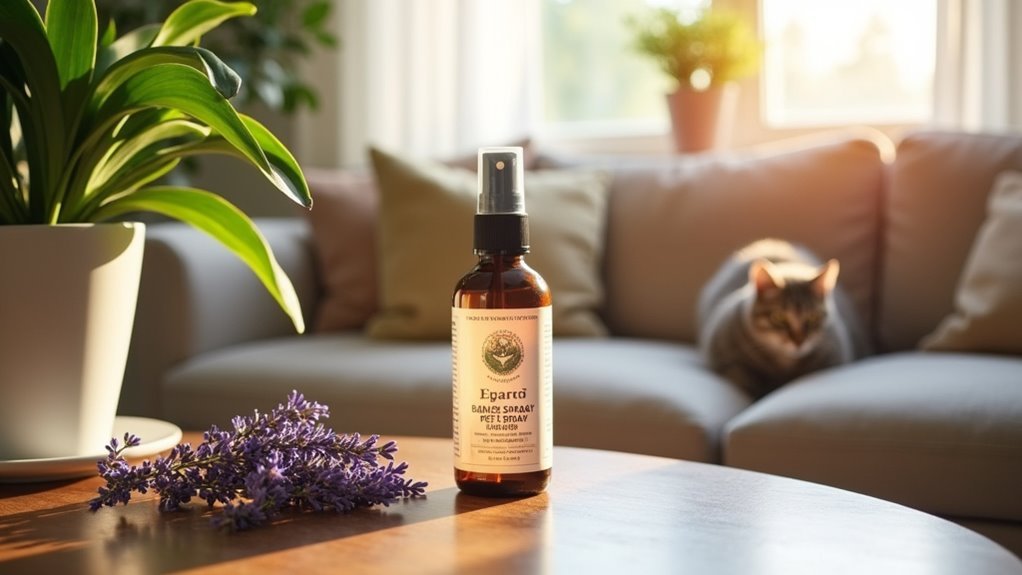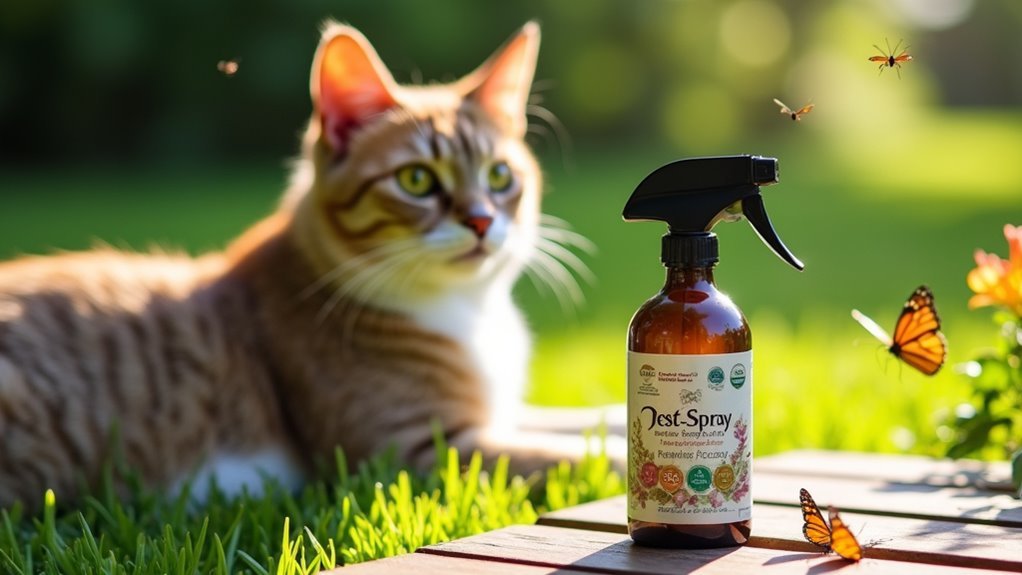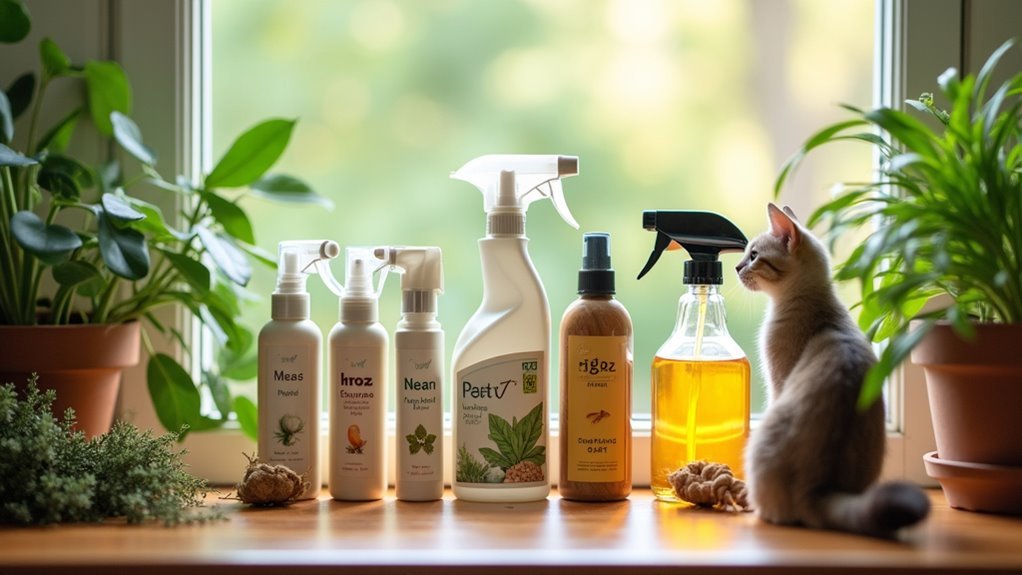When choosing pest sprays around your cat, you’ll want to select natural ingredients like cedarwood, lavender, or peppermint oils that effectively repel insects without toxic chemicals like DEET or permethrin. Always verify EPA registration and conduct patch tests before application, maintaining 6-8 inches distance from your cat’s coat while avoiding the face area. Watch for signs of exposure including excessive salivation, vomiting, lethargy, or respiratory issues, and consider professional pet-safe services for thorough protection that keeps your feline companion healthy and pest-free.
Understanding Pest Spray Ingredients That Are Safe for Cats

When you’re selecting pest sprays for your home, understanding which ingredients won’t harm your feline friends becomes essential for their safety and your peace of mind.
Focus on pet-safe pest control options featuring natural ingredients like cedarwood, lavender, and peppermint essential oils, which effectively repel insects without toxic chemicals.
Natural ingredients like cedarwood, lavender, and peppermint oils provide effective pest control while keeping your cats safe from harmful chemicals.
Diatomaceous earth offers another excellent choice—this fossilized algae powder safely dehydrates pests on contact.
Products like Pet Protect Bug Spray contain cedarwood oil without harmful chemicals such as DEET or permethrin.
Always verify Environmental Protection Agency registration and examine labels for common pest spray ingredients before purchasing.
Natural Pest Control Options Vs Chemical Alternatives
You’ll find natural pest control solutions like diatomaceous earth and cedarwood oil offer effective protection without exposing your cat to toxic chemicals.
Chemical alternatives often contain harmful ingredients that can cause gastrointestinal problems and skin irritation in felines, requiring strict safety protocols to keep your pet away from treated areas.
Natural options typically provide safer, immediate use around cats while delivering long-term pest management results.
Natural Solutions Benefits
Since you’re prioritizing your cat’s safety, natural pest control solutions offer compelling advantages over their chemical counterparts.
These natural solutions eliminate your exposure to harmful substances that traditional pest control treatments contain, protecting your feline from potential poisoning and severe health complications like skin irritations or digestive issues.
You’ll find that chemical-free pest control methods like essential oils and diatomaceous earth provide effective pest control without leaving toxic residues throughout your home.
This approach guarantees your cat won’t accidentally ingest dangerous chemicals while grooming or exploring treated areas.
Natural options also create a healthier environment for both you and your pet, reducing environmental impact while maintaining pest-free spaces.
Many solutions that are safe for pets, including lavender-based sprays, simultaneously improve your home’s ambiance while deterring unwanted insects.
Chemical Safety Risks
While natural solutions provide remarkable benefits, conventional chemical pest sprays pose significant health threats that every cat owner must understand. Pest control products often contain toxic ingredients that create serious chemical safety risks for your feline companions. These chemicals used in conventional sprays can cause gastrointestinal distress, skin irritations, and other health conditions through inhalation, skin absorption, or ingestion.
| Exposure Method | Health Risks | Severity |
|---|---|---|
| Inhalation | Respiratory distress | High |
| Skin contact | Irritation, burns | Medium |
| Ingestion | Poisoning, organ damage | Critical |
Cats are particularly sensitive to chemical pesticides, making EPA registration insufficient for ensuring the safety of your pet. Choose safe and effective natural alternatives to keep pets safe from these dangerous chemical exposures.
How to Properly Apply Pet-Friendly Sprays Around Your Home

Before you spray any pet-friendly product around your home, you’ll need to take specific preparation steps to guarantee your cat’s safety and the treatment’s effectiveness.
Proper application techniques make the difference between successful pest control and potential harm to your feline companion.
You’ll want to master both the groundwork and the actual spraying process to protect your cat while eliminating unwanted pests.
Preparation Steps for Application
When you’re ready to apply pet-friendly sprays around your home, proper preparation guarantees both safety and effectiveness.
Start with essential preparation steps by conducting a patch test on your cat to check for adverse reactions before full application.
Choose a calm environment when your pet is completely dry to reduce stress and promote better absorption.
Shake the spray bottle thoroughly to verify ingredients blend consistently for peak pest-fighting power.
During misting, maintain 6-8 inches distance from your cat’s coat to prevent over-saturation while achieving even coverage.
Plan your reapplication schedule: every 2-3 days for indoor cats or daily for outdoor cats.
Following these careful preparation steps guarantees your pet-friendly sprays deliver effective pest protection while keeping your feline companion safe and comfortable.
Safe Application Techniques
Executing proper application techniques protects your cat while maximizing pest control effectiveness.
Pet owners should always perform a patch test before using any new pest control products to guarantee your cat won’t experience allergic reactions.
When you’re ready to apply the spray, hold the bottle 6-8 inches from your cat’s coat, targeting specific areas while avoiding eyes, nose, and mouth.
Apply treatments only when your cat is calm and dry in well-ventilated spaces. This approach helps protect your pets from inhaling potentially irritating mist.
Allow treated areas to air dry completely—don’t rinse and prevent licking until fully dried.
For effective pest protection, reapply every 2-3 days for indoor cats or daily for outdoor cats to maintain peak results and keep your feline safe.
Essential Safety Precautions When Using Pest Sprays Near Cats
Although pest sprays can effectively protect your home from unwanted insects, you must take specific precautions to confirm your cat’s safety during application.
These safety precautions help prevent irritation and protect your feline companion from harmful chemicals found in many pest control products.
Before using any product, verify it’s specifically labeled as pet-safe and perform a patch test on a small skin area.
Here are essential precautions:
- Check labels for harmful chemicals like DEET or permethrin
- Keep cats away from treated areas until completely dry
- Avoid spraying near your cat’s face, eyes, and nose
- Don’t use products around young or elderly cats who are more vulnerable
These simple steps confirm effective pest control while maintaining your cat’s health and safety.
Recognizing Signs of Pesticide Exposure in Your Cat

How can you tell if your cat has been exposed to harmful pesticides? Watch for multiple warning signs that indicate contact with harsh chemicals from pest control products.
| System Affected | Mild Signs of Pesticide Exposure | Severe Symptoms |
|---|---|---|
| Gastrointestinal | Excessive salivation, vomiting | Persistent diarrhea, dehydration |
| Neurological | Lethargy, mild tremors | Seizures, difficulty walking |
| Respiratory | Light coughing | Difficulty breathing, wheezing |
| Skin | Redness, mild itching | Swelling, severe skin irritations |
Neurological symptoms like tremors or seizures indicate serious exposure levels. Respiratory distress manifests as coughing or difficulty breathing from inhaling pesticide fumes. Skin irritations develop when cats contact treated surfaces. If you notice any combination of these signs, seek veterinary attention immediately. Early treatment dramatically improves your cat’s recovery chances.
Professional Pet-Safe Pest Control Services and When to Call Them
When DIY pest control methods aren’t delivering results or you’re dealing with severe infestations, professional pest-safe pest control services offer specialized expertise that protects your cats while eliminating unwanted pests.
When selecting a pest control company, verify they use EPA-registered pet-safe products and can tailor treatment plans based on your cat’s specific needs. Clear communication about your pet’s breed, age, and health conditions helps technicians customize safe approaches.
Key considerations for professional services:
- Ask about pet-safe products and application methods before hiring
- Discuss temporarily relocating pets during major treatments like fumigation
- Follow recommended waiting times before reentry to treated areas
- Monitor your cat afterward for any signs of pesticide exposure
Your pest control technician should provide detailed guidance on protecting your feline companion throughout the entire treatment process.
Frequently Asked Questions
What Pesticide Is Safe Around Cats?
You’ll want pesticides labeled “pet-safe” or “non-toxic” specifically for cats. Choose products with essential oils like cedarwood, diatomaceous earth, or citrus extracts. Always consult your veterinarian before using any pesticide.
How Long After Spraying Pesticides Is It Safe for Cats?
You’ll need to wait 2-4 hours for indoor pesticide applications and up to 24 hours outdoors before letting your cat back in. Always check the specific product label for exact reentry times.
How Long After Pest Control Can I Let My Cat Out?
You can let your cat out after 2-4 hours for standard treatments, or 24-48 hours for intensive fumigation. Always follow your pest control company’s specific recommendations and guarantee proper ventilation first.
How Do I Get Rid of Bugs in My House Without Harming Pets?
You can eliminate bugs safely by using diatomaceous earth, essential oils like cedarwood, and sticky traps. Seal cracks, clean regularly, store food properly, and choose pet-safe products like Orange Guard citrus-based repellents.
In Summary
You’ve learned how to protect your cat while keeping pests at bay. Remember, you’re responsible for reading labels carefully, choosing natural alternatives when possible, and watching for signs of exposure. Don’t hesitate to contact professionals if you’re unsure about any product’s safety. Your cat’s health should always come first, so when in doubt, opt for the safest pest control method available.





Leave a Reply